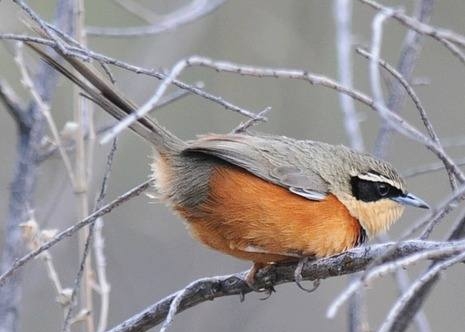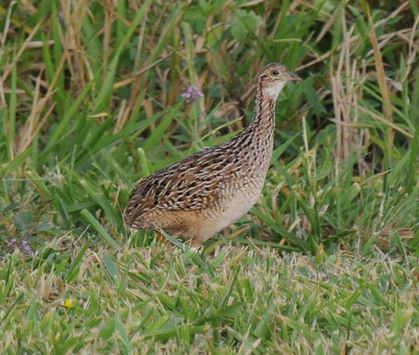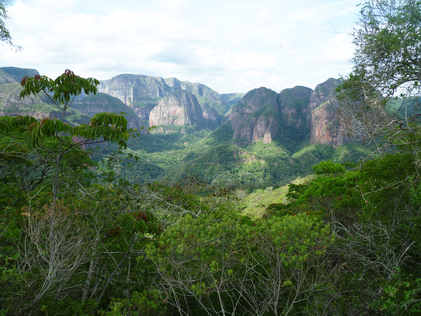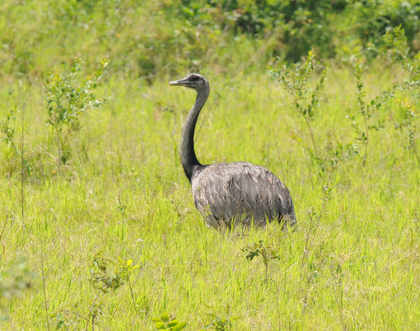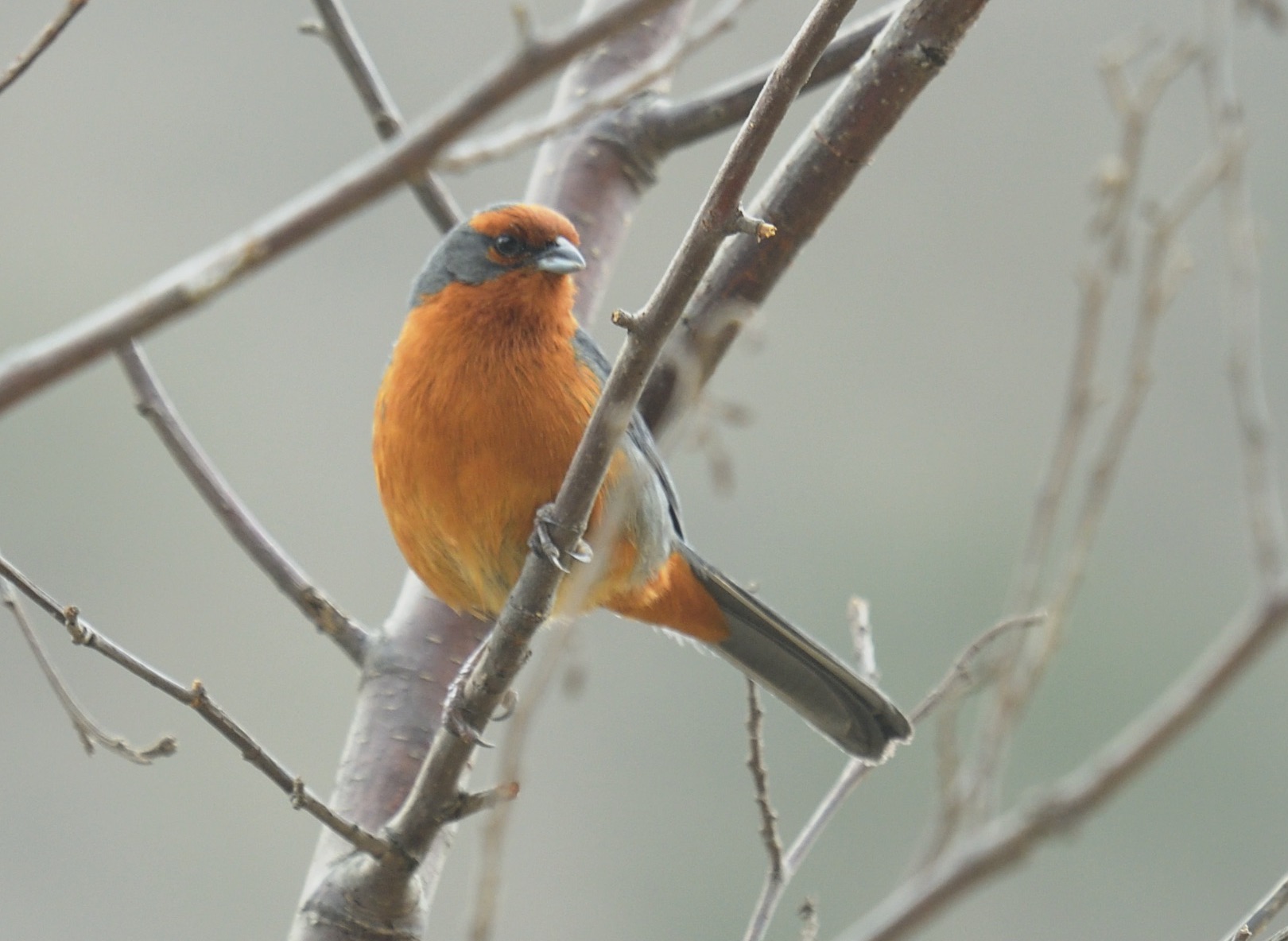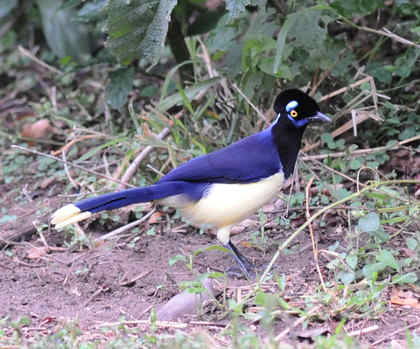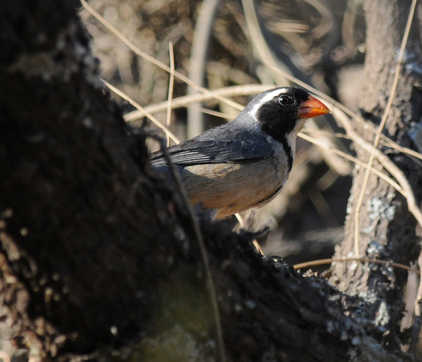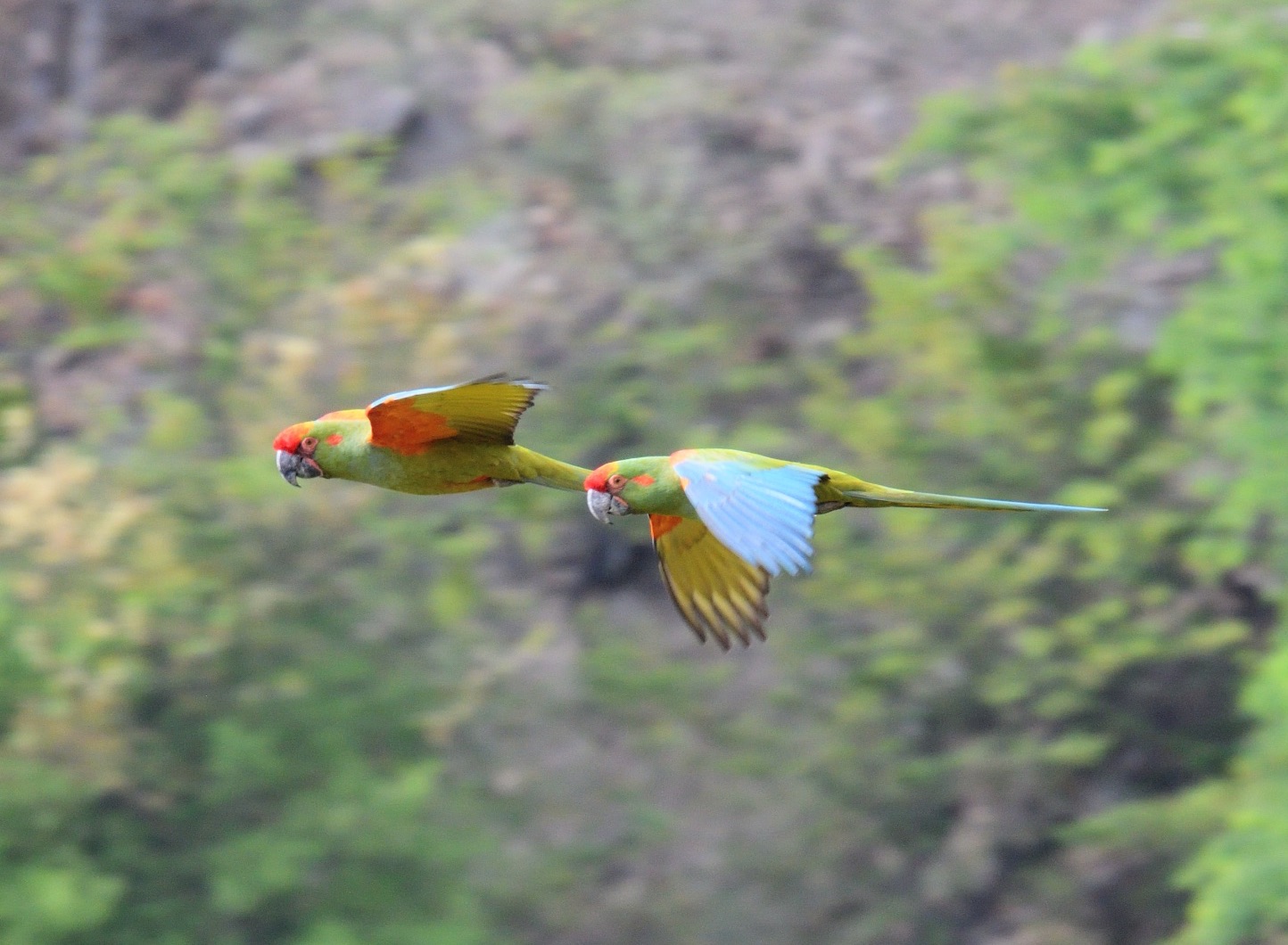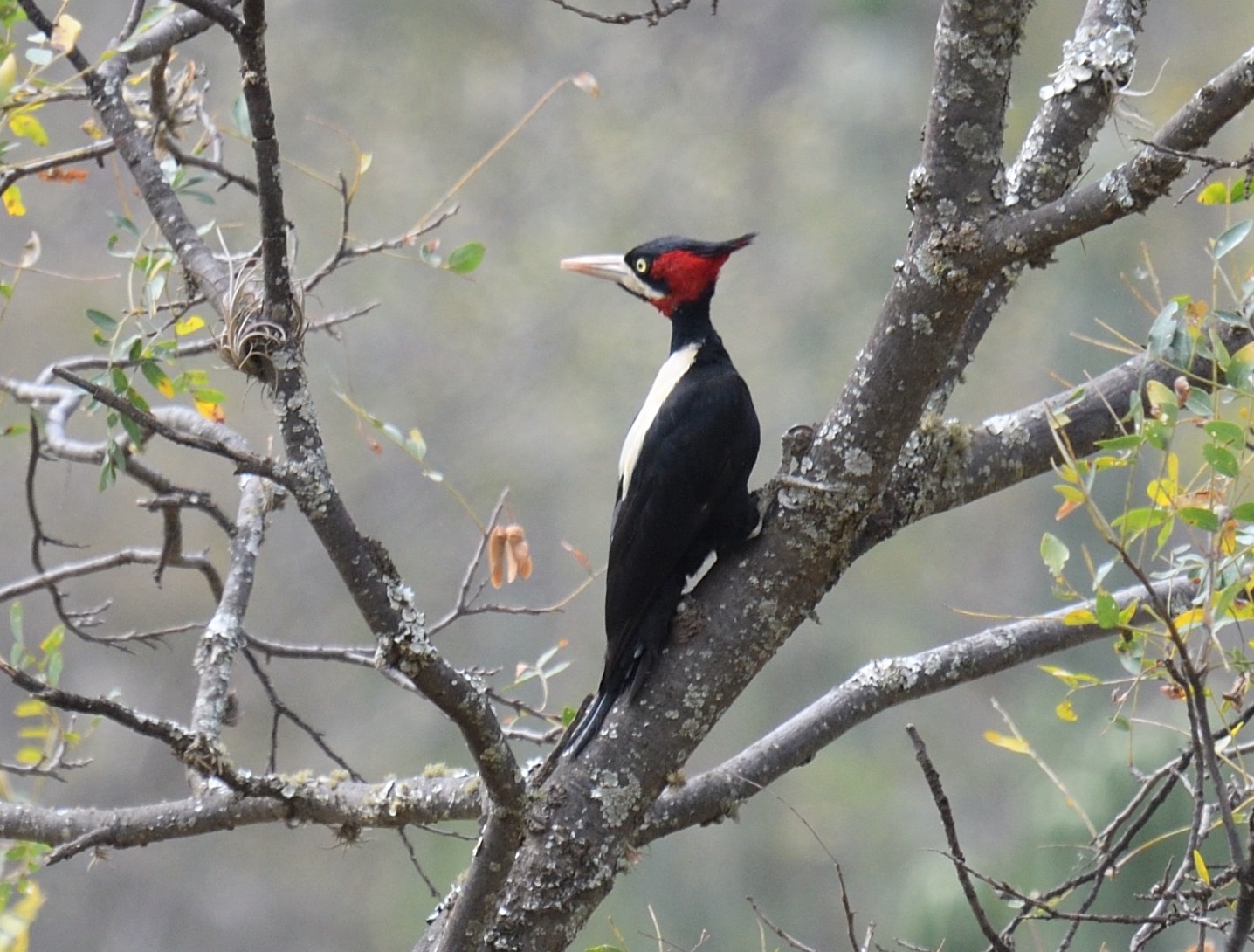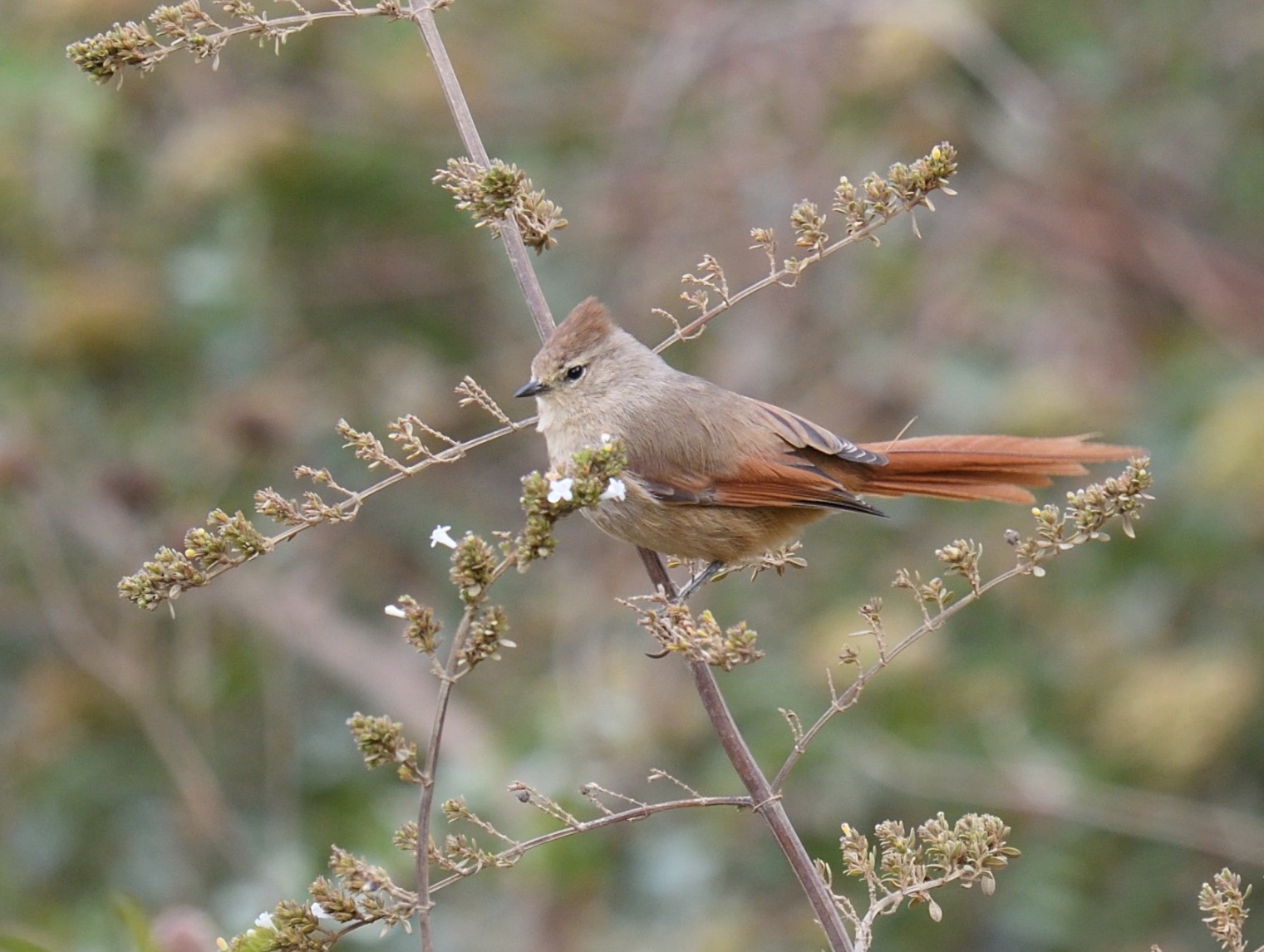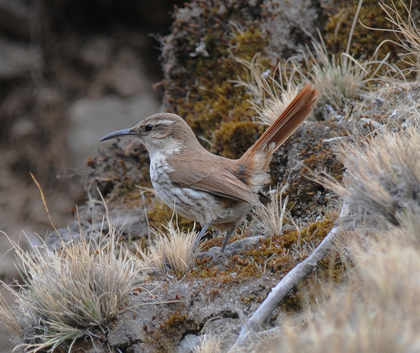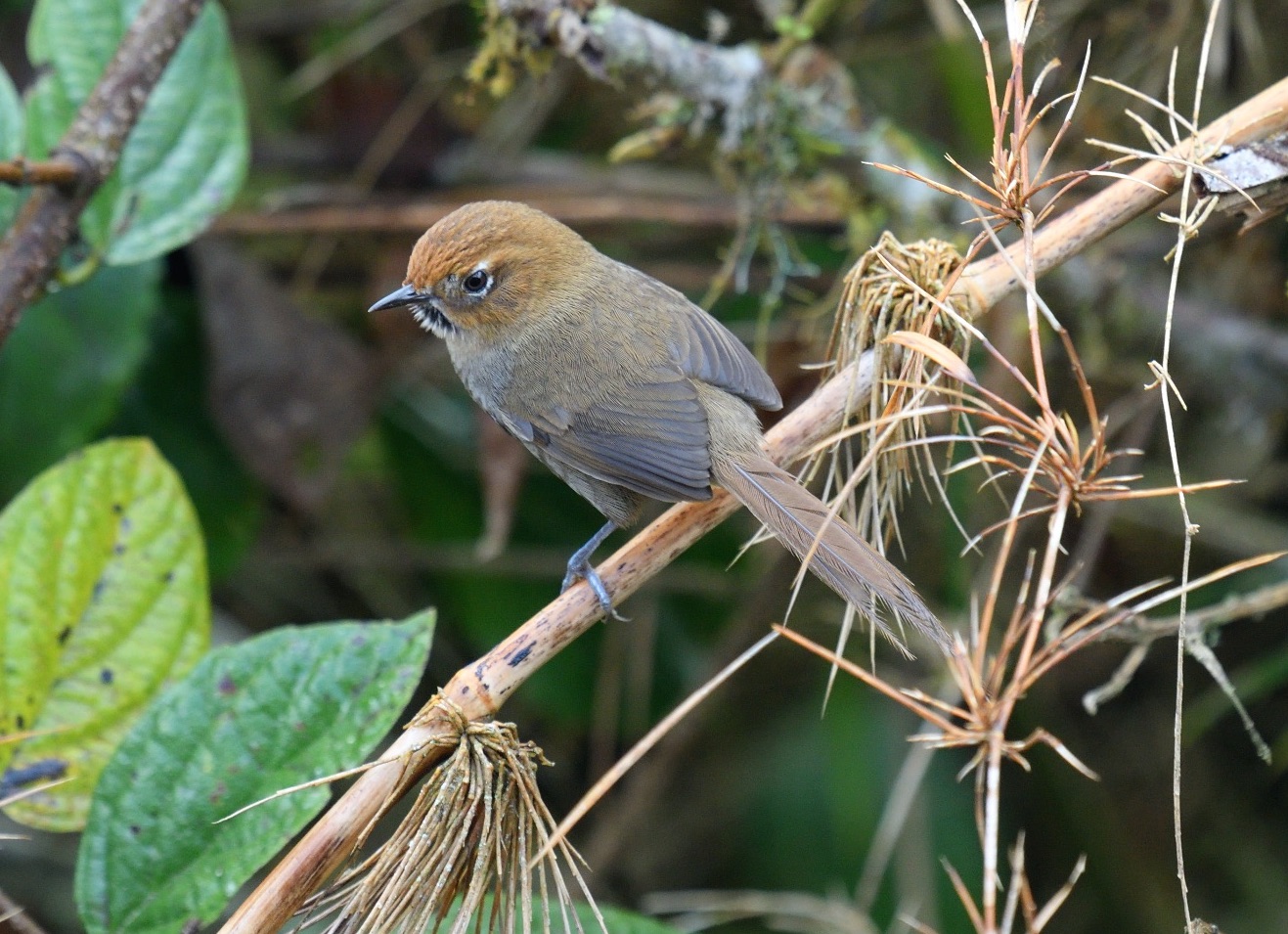BOLIVIA - BEST OF THE ANDES
ITINERARY FOR BLUE-THROATED MACAW PRE-TOUR EXTENSION: AUGUST 23rd - 28th
Much of the Department of Beni is in a life zone known as the Llanos de los Moxos or Moxos savanna. This habitat is a mix of dry woodlands, riparian gallery forest, grasslands and palm savannas and is seasonally flooded, although our visit is timed at the height of the dry season. It is in islands of palms in this sea of grass where the endemic and critically endangered (estimated to number about 300 birds) Blue-throated Macaw is found. For many years this spectacular macaw was known only from specimens and live birds in the possession of parrot collectors, caught by poachers in unknown areas. It was only in the mid 1990s that biologists and conservationists discovered where the few birds still resided. It is right in the middle of this distribution that we will be staying in a wonderful private cattle ranch, which now supplements its income by showing people this magnificent bird, and strives to help in its conservation. The wonderful aspect of this extension is that we get into this little-known part of South America, which is rich, rich, rich in diversity!
Pre-tour Day 1 Arrival in Santa Cruz for Extension - 23rd August
Following international flights from UK/Europe/USA, plan to arrive this morning in Santa Cruz. Upon landing, have your binoculars handy: the Viru-Viru Airport (named for a local plant), north of town, is surrounded by beautiful grassland, and it’s hard to get out of it without seeing something exciting, perhaps Red-winged Tinamous, Burrowing Owls, a Whistling Heron, or Fork-tailed Flycatcher at this time of year. If we are raring to go after our long flight then further exploration could produce species such as Greater Rhea, Small-billed Tinamou, Darwin's and White-bellied Nothuras, Limpkin, Brazilian Teal, Buff-necked Ibis, Red-legged Seriema, Yellow-headed Caracara, Long-winged Harrier, Savanna, White-tailed Hawk, Wattled Jacana, Nacunda Nighthawk, Short-tailed Swift, White-eyed and Canary-winged Parakeets, Rufous Hornero, Fork-tailed Flycatcher, Red-breasted Blackbird, Sayaca Tanager, Great Pampa-Finch and possibly Rufous-rumped and Dark-throated Seedeaters. Assuming an on-time arrival (which is not always the case), we may want to bird some nearby woodland in order to absorb some new birds for a couple of hours. (You’ll have access to your luggage and to nice restrooms at the airport if you need to grab optics or an item of clothing.) Further possibilities today include Picui Ground-Dove, Variegated Flycatcher, Plain Tyrannulet, Creamy-bellied Thrush, Thrush-like Wren, Black-backed Grosbeak and Crested Oropendola. Once we are finished we'll check into our rooms at a nice local hotel and have lunch and a siesta at our air-conditioned hotel before doing some more birding in the late afternoon.
In April, the lowlands of Santa Cruz can be alive with wintering and migrating Austral migrants—a phenomenon little studied in the south. These include many species found in the poorly studied Chaco and Monte Desert of Argentina such as White-banded Mockingbird, Rufous Casiornis, Cinereous Tyrant, and Hudson’s Black- Tyrant.
If you are arriving separately from the group and are
not arriving at or about the same time as the recommended group flight, please plan to make your own way to the hotel (taxis are available). Night in Santa Cruz.
Pre-tour Day 2 Santa Cruz - Trinidad
We’ll catch our local flight to Trinidad this morning and arrive mid-morning at the Trinidad airport. For the extension, we recommend including a small, collapsible duffle so you can repack light clothing for five days of warm weather, rubber boots, a sweater (important—cold fronts are still possible this time of year!), and raingear. We are allowed only about 20 kg of checked luggage on the flight to Trinidad (it is a twin-prop, 19-seater plane with no overhead bins). You may leave the rest of your luggage safely stored at the hotel in Santa Cruz. After retrieving our luggage, we'll be met by our ground agents and will likely bird in the incredibly diverse seasonally-flooded habitats around the town with a stop for a delicious lunch of river fish. In the afternoon, we’ll be transferred to our hotel on the edge of town. Night in Trinidad.
Pre-tour Day 3 Trinidad to El Cutal
We'll depart early this morning after breakfast for the drive to our hacienda in the heart of the Beni. Although the drive does not normally take all day, we'll surely make a number of birding stops along the way, which will delay our arrival at the hacienda until early afternoon. Our accommodation for the next two nights are simple, yet comfortable, but space at the hacienda necessitates doubling or tripling up, bathroom facilities here are shared, but the food is excellent and is served in generous portions.
We’ll travel to the estancia in an open truck, birding all the way, and the bird list here is amazingly long. Some of the goodies that we’ll search for during our visit, besides the fabulous endemic Blue-throated Macaw, are Crowned Eagle (one of the best places we know of for this rare raptor), Orinoco Goose, Plain Softtail (the endemic nominate race fusciceps), Cinereous-breasted Spinetail, Sulphur-bellied Tyrant-Manakin, Hudson’s Black-Tyrant, Dark-throated Seedeater, and the endemic boliviensis race of Velvet-fronted Grackle. Interestingly, some species from these parts of Bolivia are well differentiated from those found elsewhere in South America and may prove to be separate species. Accommodation will be in the house of the estancia, a working cattle ranch. Night at El Cutal.
Pre-tour Day 4 Llanos de Los Moxos
We'll have today and part of tomorrow to spend looking for the Blue-throated Macaw and other birds of the area and all of our birding will be done along level roads or trails or from the back of our open-air truck. Amongst many possibilities not previously mentioned we can find Undulated Tinamou, Razor-billed Curassow, Jabiru, Sunbittern, Cocoi, Whistling and Capped Herons, Sungrebe, Southern Screamer, Roseate Spoonbill, Green, Plumbeous and Bare-faced Ibis, Ash-throated Crake, Lesser Yellow-headed Vuture, Long-winged Harrier, Great Black Hawk, Black-collared Hawk, South American Snipe, Large-billed and Yellow-billed Terns, Red-and-green, Golden-collared, Chestnut-fronted and Blue-and-yellow Macaws, Turquoise-fronted Amazon, Peach-fronted, Dusky-headed, White-eyed, Cobalt-winged and Yellow-chevroned Parakeets, Toco Toucan, Ash-coloured and Striped Cuckoos, Great Potoo, Little Nightjar, White-wedged Piculet, White, Golden-green, Yellow-tufted and Pale-crested Woodpeckers, Black-tailed Trogon, Rusty-backed Antwren, Great Rufous and Narrow-billed Woodcreepers, Swallow-tailed and Gilded Hummingbirds, Blue-tailed Emerald, White-tailed Goldenthroat, Buff-throated Woodcreeper, Greater and Rufous-fronted Thornbirds, White-winged and Tawny-headed Swallows, Grey-crested Cachalote, Hauxwell's Thrush, Large Elaenia, Yellow Tyrannulet, White-headed Marsh-Tyrant, Cattle, Yellow-browed and Spectacled Tyrants, White and White-rumped Monjitas, Band-tailed Manakin, Golden-crowned Warbler, Plush-crested Jay, Unicolored and Scarlet-headed Blackbirds, Rusty-collared and Great-billed Seedeaters, Re-capped Cardinal and Long-tailed Reedfinch. There's also a chance of Giant Anteater, along with Capybara and Crab-eating Fox. Night at El Cutal.
Pre-tour Day 5 El Cutal to Trinidad
We'll have part of the morning for some final birding around the hacienda and then drive back to Trinidad after lunch. Other species we can find in the gallery forest nearby include Pheasant Cuckoo, Crimson-crested Woodpecker, Red-billed Scythebill, Mato Grosso Antbird, Bare-necked Fruitcrow, Rufous-crowned Greenlet, and both Grey-headed and Orange-headed Tanagers. The afternoon will be spent birding near our lodging on the outskirts of Trinidad. Night in Trinidad.
Pre-tour Day 6 Return to Santa Cruz; main tour begins - 28th August
We’ll have this morning to bird around Trinidad before taking a short flight back to Santa Cruz, where well meet those who have arrived for the main tour at the hotel to begin Day 1 of the main tour around lunchtime. Night in Santa Cruz.
MAIN TOUR ITINERARY: 28th August - 12th September
Day 1 Arrival in Santa Cruz - 28th August
Following international flights from UK/Europe/USA, plan to arrive this morning in Santa Cruz. Upon landing, have your binoculars handy as the Viru-Viru Airport (named for a local plant), north of town, is surrounded by beautiful grassland and it’s hard to get out of it without seeing something exciting, perhaps Red-winged Tinamou, Burrowing Owls, a Whistling Heron, or Fork-tailed Flycatcher at this time of year. If we are raring to go after our long flight then further exploration could produce species such as Greater Rhea, Small-billed Tinamou, Darwin's and White-bellied Nothuras, Limpkin, Brazilian Teal, Buff-necked Ibis, Red-legged Seriema, Yellow-headed Caracara, Long-winged Harrier, Savanna, White-tailed Hawk, Wattled Jacana, Nacunda Nighthawk, Short-tailed Swift, White-eyed and Canary-winged Parakeets, Rufous Hornero, Red-breasted Blackbird, Sayaca Tanager, Great Pampa-Finch and possibly Rufous-rumped and Dark-throated Seedeaters. Assuming an on-time arrival (which is not always the case), we may want to bird some nearby woodland in order to absorb some new birds for a couple of hours. (You’ll have access to your luggage and to nice restrooms at the airport if you need to grab optics or an item of clothing.) Further possibilities today include Turquoise-fronted Amazon, Scaly-headed Parrot, Picui Ground-Dove, Stripe-backed Antbird, Variegated Flycatcher, Plain Tyrannulet, Creamy-bellied Thrush, Flavescent Warbler, Thrush-like Wren, Black-backed Grosbeak and Crested Oropendola. Once we are finished we'll check into our air-conditioned rooms at a nice local hotel and have lunch and a siesta before doing some more birding in the late afternoon. We'll also meet up with the rest of the group who have returned to Santa Cruz from the Blue-throated Macaw extension.
In April, the lowlands of Santa Cruz can be alive with wintering and migrating Austral migrants—a phenomenon little studied in the south. These include many species found in the poorly studied Chaco and Monte Desert of Argentina such as White-banded Mockingbird, Rufous Casiornis, Cinereous Tyrant and Hudson’s Black-Tyrant. We’ll have the best part of two days of birding in the Santa Cruz area, insuring more time for the lowland specialties—and offering a chance to experience the Austral migrants.
If you are arriving separately from the group and are not arriving at or about the same time as the recommended group flight, please plan to make your own way to the hotel where we will meet for lunch. (Taxis are available.) Night in Santa Cruz.
Day 2 Santa Cruz - Lomas de Arena - Refugio Los Volcanes
We will leave early this morning to visit an interesting reserve near the city called Lomas de Arena, which is an area of Chaco-like campos and marshy savanna and is also famous for its impressive sand dunes. A wide variety of potential species awaits us here and potential new birds include White-bellied Nothura, Crested and Brushland Tinamous, Chaco Chachalaca, Bare-faced Currasow, Ringed Teal, Comb and Lake Ducks, Whistling Heron, Red-legged Seriema, Crane and Zone-tailed Hawks, Crowned Eagle, Southern Lapwing, Toco Toucan, Blue-winged Parrotlet, Golden-collared and Military Macaws, Monk Parakeet, White-wedged and White-barred Piculets, Campo Flicker, White and Checkered Woodpeckers, Guira Cuckoo, Blue-crowned Motmot, White-eared Puffbird, Red-billed Scythebill, White-lored and Chotoy Spinetails, White-rumped Monjita, Great and Bolivian Slaty Antshrikes, Mato Grosso and Stripe-backed Antbirds, Straneck’s Tyrannulet, Fawn-breasted Wren, Ashy-tailed Swift, Blue-tufted Starthroat, Great Rufous and Scimitar-billed Woodcreepers, Common, Greater, Streak-fronted and Little Thornbirds, Red-billed Scythebill, Brown Cacholote, Crested Hornero, Chaco Earthcreeper, Short-billed Canastero, Cinereous and Spectacled Tyrants, Austral Negrito, Fawn-breasted Wren, Rufous Casiornis, White-banded Mockingbird, Rust-and-yellow Tanager, Saffron Finch, Red-crested and Red-capped Cardinals, Dark-throated Seedeater, Stripe-capped Sparrow and Black-crested Finch. We don't expect to see all of the above named species but we'll try!
Once bird activity has quietened due to the heat of the day we will have lunch and then leave the Santa Cruz area behind and head west into the foothills where a very different habitat will greet us. We will be spending these next two nights at a nice, quiet lodge “off the beaten path” called Refugio los Volcanes. It lies at the bottom of a very scenic valley with tall, impressive red sandstone cliffs surrounding it and an interesting semi-deciduous foothill forest on our doorstep. Night at Refugio los Volcanes.
Day 3 Refugio Los Volcanes
Today will be spent walking the trails around the lodge and birding the interesting foothill forest that basically represents the southernmost extent of “Amazonian” foothill habitat. Within the splendidly scenic environs of Refugio Los Volcanes there are many interesting birds to look for including Grey Tinamou, Andean Condor, King Vulture, Black-chested Buzzard-Eagle, Rufescent Scops-Owl, Band-bellied Owl, Rufous Nightjar, Ocellated Poorwill, Toco Toucan, Chestnut-tipped Toucanet, Military Macaw, Blue-fronted and Scaly-naped Parrots, Green-cheeked, Mitred and Yellow-chevroned Parakeets, Andean Motmot, Masked Trogon, Ocellated Piculet, White-tipped Swift, Short-tailed Antthrush, Chestnut-backed Antshrike, Black-capped and Ashy Antwren, Plain Antvireo, Streaked Xenops, Ochre-cheeked Spinetail, Buff-browed Foliage-gleaner, Sharp-tailed Streamcreeper, Cinnamon-throated and Ocellated Woodcreepers, Slaty Elaenia, Thrush-like Wren, Black-capped Antwren, White-backed Fire-eye, the elusive Slaty Gnateater, White-winged Becard, White-necked Thrush, the endemic Bolivian Recurvebill, White-backed Fire-eye, Cliff, Yellow-olive, Sulphur-bellied and Pale-edged Flycatchers, Rough-legged Tyrannulet, Moustached Wren, White-bellied Pygmy-Tyrant, Ochre-faced Tody-Flycatcher, Yungas Manakin, Amethyst and Slender-tailed Woodstars, Buff-bellied and Planalto Hermits, Sapphire-spangled Emerald, White-bellied Hummingbird, Golden-rumped Euphonia, Chestnut-vented Conebill, Two-banded Warbler, Masked Yellowthroat, Dusky-green Oropendola, Hooded Siskin, Blue-browed, White-winged and Black-goggled Tanagers, and the stunning Plush-crested Jay. Night at Refugio Los Volcanes.
Day 4 Refugio Los Volcanes - Comarapa
Depending on our success or otherwise yesterday we can spend the first couple of hours revisiting some of the trails close to the lodge this morning before we have to leave this wonderful area and transfer via jeeps to our coach, which will be waiting at the rim of the crater for us. We may pop in to a nearby pond where Masked Duck and other waterbirds can be found before we head west into semi-humid forest on the lower mountain slopes that surround our next hotel. But first we'll bird our way along the road for a few hours for species such as Blue-throated Piping-Guan, Blue-crowned Trogon, White-tipped Swift, Purple-throated Euphonia and many more.
Continuing westward, with a birding stop or two along the way (and a picnic lunch), we’ll enter a zone of arid inter-Andean valleys lying within a rain shadow formed by the surrounding mountains. Around late afternoon we’ll pull into the little village of Comarapa where the dry, cactus-spiked gullies that dominate the landscape lend the region that distinctive, haunting character that only deserts possess. There's a whole new suite of birds in this habitat such as Blue-crowned Parakeet, White-fronted Woodpecker, Narrow-billed Woodcreeper, Masked Gnatcatcher, Stripe-crowned Spinetail, Southern Scrub Flycatcher, Crowned Slaty-Flycatcher, Southern Beardless Tyrannulet, Small-billed Elaenia, Pearly-vented Tody-Tyrant, Glittering-bellied Emerald, Yellow-browed Tyrant, Blue-and-yellow Tanager, Ringed Warbling-Finch, Epaulet (Variable) Oriole, Ultramarine Grosbeak and Golden-billed Saltator. This will also be our first chance at seeing the wonderful endemic Red-fronted Macaw flying over to their roost site. This part of Bolivia is completely undeveloped and far from any town that amounts to more than a crossroads. We will be staying at a basic but comfortable hotel in Comarapa for the next three nights.
Days 5 - 6 Comarapa - Serrania de Siberia
Birding the hot, dry habitats near Comarapa dictates that we concentrate our efforts in the early morning and late afternoon. Certainly the most special bird we’ll strive to see here is the endemic Red-fronted Macaw. This large green macaw, highlighted with scarlet forehead and underwings, brilliant blue primaries and tail, and flaming orange epaulets, is not only one of the most spectacular of all macaws, it also ranks among the rarest birds in South America. It is estimated that fewer than 3000 Red-fronted Macaws remain in the wild, restricted to arid canyons in the central Bolivian Andes. These birds are erratic, moving long distances tracking food supplies, but with perseverance and a little luck, we could come away with excellent views of these magnificent birds. Along the way we may well find our first Andean Guans feeding quietly beside the road before we drop down to the lower valleys and canyons where we can also find a colony of endemic Cliff Parakeets, as well as Green-cheeked Parakeet, Spot-backed Puffbird, endemic Bolivian Earthcreeper, Sooty-fronted Spinetail, Chaco Suiriri, Fuscous Flycatcher, White-winged Black-Tyrant, Blue-tufted Starthroat, Chivi Vireo, Tropical Parula, Black-capped Warbling-Finch, Grey-crested Finch, White-tipped Plantcutter and many more.
Further west are shrub-clad slopes with a patchwork of alders and cultivated fields rising to an altitude of 8500 feet. Then, around a bend, where clouds often spill over from the east slope, lies humid montane cloudforest with tall, epiphyte-laden trees and beautiful flowers. In these habitats we’ll seek Andean Tinamou, the endemic Huayco Tinamou (a recent split from Red-winged Tinamou), Violet-throated Starfrontlet, endemic Blue-capped Puffleg, stunning Red-tailed Comet, Spot-breasted Thornbird, Giant Antshrike, endemic Rufous-faced Antpitta, Trilling (Grey) Tapaculo (a recent split from Unicolored), Olive-crowned Crescentchest, Chestnut-crested Cotinga, Brown-capped Redstart, Blue-winged and Chestnut-bellied Mountain-Tanagers, endemic Bolivian Warbling-Finch, both Rufous-sided and Rusty-browed Warbling-Finches, and the endemic Grey-bellied Flowerpiercer.
The cloudforests of the Serranía de Siberia, straddling the border of Santa Cruz and Cochabamba departments are just a couple of hours west of Comarapa and the serranía is high enough (8000-9000 feet) to catch the last of the moisture-laden easterlies. This is the southernmost of the Andes’ humid “tropical” cloudforest, and as such, it marks the southern terminus in the distribution of numerous species of high-elevation forest birds. Siberia is a fascinating region that each year rewards us not only with the expected, but usually a surprise or two as well. Birding will be along level roads and on trails (with some climbing near Siberia) in both the arid zone and in the cloudforest. The cloudforest trails are sometimes muddy, although not too long or particularly steep and waterproof footwear and raingear are recommended. We will leave Comarapa very early and drive up to Siberia cloud forest where the cool, misty forest-cloaked mountains hold Brown Tinamou, Mountain Caracara, Yungas Pygmy-Owl, Scaly-naped Parrot, Bar-bellied Woodpecker, Pearled Treerunner, Azara's and Light-crowned Spinetails, Variable Antshrike, Red-crested Cotinga, Spotted Nightingale-Thrush, White-crested and Highland Elaenias, White-throated Tyrannulet, Cinnamon Flycatcher, Mountain Wren, Andean Tyrant, Andean Slaty-Thrush, Great Thrush, Blue-backed Conebill, Rufous-breasted Chat-Tyrant, Brown-capped Redstart, Pale-legged Warbler, Speckled Hummingbird, Trilling Tapaculo, Masked Flowerpiercer, Tyrian Metaltail, Blue-winged Mountain-Tanager, Blue-and-black, Blue-capped and Fawn-breasted Tanagers and endemic Bolivian Brush-Finch. Two nights in Comarapa.
Day 7 Comarapa - Siberia Cloud Forest - Cochabamba
Following an early morning birding stop, probably in the Siberia cloudforest, we’ll drive to Cochabamba with a picnic lunch and make some birding stops in dry, temperate scrub along the way. We’ll be lodged in a fine hotel in the old city of Cochabamba (about 8300 feet) for the next five nights. Night in Cochabamba.
Days 8 - 11 Cochabamba - Chapare
Straddling a section of the Andes known as the Cordillera Cochabamba and offering a well-developed network of roads (although we can’t say as much for the condition of some of them), the department of Cochabamba offers excellent access to all of the important Andean habitats from upper tropical, subtropical and temperate forest on the wet Amazonian slope to arid temperate scrub, puna grassland, and Polylepis woodland on the dry intermontane side. We’ll have four full days to bird this striking diversity of habitats, ranging in elevation from as low as 3000 feet to as high as around 13,000 feet. Just where we bird on each day will depend as much upon the weather as anything and we usually have to dodge some rain showers or fog by going up or down the wet slope. Although it is smaller than most of the other departments, Cochabamba harbors more of the Bolivian endemic birds than any other, so we’ll prioritize these specialties and enjoy everything else we see along the way. That means spending most of our time in the intermontane valleys and on the forested east slope down to upper tropical elevations, mostly 3000 feet and up. We’ll need to depart Cochabamba very early on these days in order to be in the best birding areas as the sun comes up. After a picnic breakfast, we’ll watch an impressive burst of activity among hummers, flowerpiercers, furnariids and flocking tanagers as the sun bathes the slopes at the treeline. Weather permitting, we’ll spend one entire day in the temperate forest zone, birding the bamboo flocks and hoping for such rarities as Hooded Mountain-Toucan and Chestnut-crested Cotinga in the forest below. We’ll try some side roads and trails that take us into the alluring forest and roadside and forest trail birding is not too strenuous, but it is important to be prepared for rain (and to have waterproof footwear with you on the bus). To maximize our time in the field, we’ll prepare picnic meals and be back at the hotel for dinner.
Probably on our first morning, we will visit the nearby Cerro Tunari. This is a mountain just northwest of the city where we’ll have access to the drier montane habitats on the rain-shadow side of the valley. Good hiking boots are usually best for this area. Birds such as Cinereous Harrier, Variable Hawk, Aplomado Falcon, Bare-faced Ground-Dove, Scribble-tailed and Cream-breasted Canasteros, Great and Chiguanco Thrushes, Olive-crowned Crescentchest, endemic Bolivian Blackbird, near-endemic Fulvous-headed Brush-Finch, near-endemic Bolivian and Rufous-sided Warbling-Finches and near-endemic Rufous-bellied Saltator will be among the species we’re likely to enjoy during our picnic breakfast. Farther upslope, Andean Swift, Great Saphirewing, Black-breasted Hillstar, Red-tailed Comet, Striped Woodpecker, Creamy-breasted and endemic Maquis Canasteros, Brown-capped Tit-Spinetail, Streak-fronted Thornbird, both Rock and endemic Bolivian Earthcreepers, Slender-billed Miner, Brown-capped Redstart, Yellow-billed Tit-Tyrant, White-browed Chat-Tyrant live in the arid scrub that is dotted with cactus. Higher still, we enter a Polylepis woodland where Giant and Cinereous Conebills, Brown-capped and Tawny Tit-Spinetails, and perhaps Andean or Grey-hooded Parakeets will show themselves to us. Finally, we will climb into the puna zone (11,000 to 13,000 feet) where we will have our first experience with thin air, as well as Andean Tinamou, Andean Lapwings, several species of ground-tyrant, Puna Tapaculo, Yellow-bellied Siskin, White-winged Diuca-Finch, Great Pampa-Finch, and Llama and Alpaca herds that dot this foreboding landscape.
Other Intermontane possibilities include Andean Tinamou, Torrent Duck, Black-chested Buzzard-Eagle, the near-endemic and rather rare Wedge-tailed Hillstar, Andean Hillstar, Giant Hummingbird, Red-tailed Comet, White-faced (Large-tailed) Dove, Bare-faced Ground-Dove, Plain-breasted Earthcreeper, White-winged Cinclodes, endemic Maquis Canastero, Scribble-tailed Canastero, D’Orbigny’s and White-browed Chat-Tyrants, Rufous-webbed Tyrant, near-endemic Brown-backed Mockingbird, Fulvous-headed Brush-Finch, Giant Conebill (rare), Black-hooded Sierra-Finch, near-endemic Short-tailed Finch (scarce), near-endemic Bolivian Warbling-Finch, endemic Cochabamba Mountain-Finch, endemic Citron-headed (rare), Greenish and Bright-rumped Yellow-Finches, endemic Grey-bellied Flowerpiercer, and endemic Bolivian Blackbird.
Just a few of the many birds we’ll hope to see in the Chapare (the geographic region of Cochabamba department that lies on the forested Amazonian slope of the Andes, from treeline down to the lowlands) are the rare Solitary and Black-and-chestnut Eagles, near-endemic and rare Black-winged and Speckle-faced (Plum-crowned) Parrots, near-endemic Yungas Pygmy-Owl (rare), Swallow-tailed Nightjar (rare), Violet-fronted Brilliant, endemic Black-hooded Sunbeam, Bronzy and Collared (Gould’s) Incas, Amethyst-throated Sunangel, Booted Racket-tail, Scaled Metaltail, Long-tailed Sylph, Crested and Golden-headed quetzals, Masked Trogon, Versicolored Barbet, Blue-banded and Chestnut-tipped Toucanets, near-endemic Hooded Mountain-Toucan, Crimson-mantled Woodpecker, Olive-backed Woodcreeper, endemic Black-throated Thistletail, near-endemic Light-crowned Spinetail, Montane Foliage-Gleaner, near-endemic Upland Antshrike, near-endemic Yellow-rumped Antwren (rare), White-throated Antpitta, Rufous Antpitta (of the distinct-sounding race cochabambae), near-endemic Slaty Gnateater, Bolivian Tapaculo (also known as Southern White-crowned Tapaculo Scytalopus bolivianus, a split from Rufous-vented and a tough skulker), Andean Cock-of-the-rock, Yungas Manakin, endemic Yungas Tody-Tyrant (scarce), Sclater’s, Bolivian and Buff-banded Tyrannulets, Rufous-bellied Bush-Tyrant, near-endemic Band-tailed Fruiteater, White-capped Dipper, Andean and White-eared Solitaires, White-browed Conebill, near-endemic Orange-browed and Three-striped Hemispinguses, Hooded and Scarlet-bellied Mountain-Tanagers, Golden-collared Tanager, Saffron-crowned, Blue-necked, Blue-and-black, and Straw-backed Tanagers, and both Moustached and Deep-blue Flowerpiercers. Nights in Cochabamba.
Day 12 Cochabamba - Laguna Alalay - La Paz
This morning we will send our bags off with the driver and carry only what we will need for an easy morning's birding at a great local patch at the edge of Cochabamba - Laguna Alalay. This lake has provided some exceptional records for Bolivia—it is the first (and only?) locality in the country for Red-fronted Coot, which only showed up less than a decade ago. It is also a great place to see ducks such as Yellow-billed and Puna Teals, Red Shoveler, White-cheeked Pintail, Red-billed Pochard, even the rare Silver Teal, White-tufted Grebe, Puna and White-faced Ibis, Andean Lapwing, Andean Avocet, Baird’s Sandpiper, Andean Gull, Cream-winged Cinclodes, Yellow-winged Blackbird, Many-colored Rush-Tyrant, Wren-like Rushbird, Andean Negrito, and the lovely Plumbeous Rail. The local form of Great Kiskadee is a giant and washed out, and it occurs higher here in Bolivia than anywhere else in its range! After lunch we will fly to La Paz, avoiding a long and dusty drive, arriving at the hotel at about the same time as our bags that have come overland. Night in La Paz.
Day 13 La Paz - Coroico
La Paz encompasses a
tremendous transect of habitats on both wet and dry slopes
of the Andes. Our birding in La Paz will take us over the
high pass (around 15,500 feet) at La Cumbre to the humid-
temperate and subtropical forests on the east slope. One of
these mornings, following more than two weeks of
acclimatization to the altitude, we’ll take advantage of the
rare access to the beautiful, high pincushion bogs provided
at La Cumbre itself. We’ll drive a long transect, birding a variety of locales ranging from high puna bogs, altiplano, and high Andean cloudforest. The road that takes us over the pass at La Cumbre continues down to the lowlands, traversing some interesting forest at upper elevations along the way. It’s a narrow, winding road, affording breathtaking vistas of distant ridges and steep-walled valleys shrouded in clouds at every turn. We will spend one night in a hotel at the bottom of this road to give us a morning in the lower elevations, with the option of leaving our larger luggage at our hotel in La Paz tonight.
Birding among the high altitude Elfin forest and paramo gives us further opportunities to find any species we still need as well as yet mroe new ones and possibilities include Andean Flicker, Ash-breasted Tit-Tyrant, Red-crested Cotinga, Barred Fruiteater, Paramo Pipit, Olivaceous and Blue-mantled Thornbills, Great Saphirewing, Andean Hillstar, Violet-throated Starfrontlet, Streak-throated, Scribble-tailed and Line-fronted Canasteros, Tawny Tit-Spinetail, Black-throated Thistletail, Rufous-faced and Stripe-headed Antpitta, White-fronted, Puna and Cinereous Ground-Tyrants, Black Siskin, Plumbeous and Ash-breasted Sierra-Finches, White-winged Diuca-Finch, and both Puna and Diademed Tapaculos. We then descend in elevation to try further areas for Scimitar-winged Piha, Brown-backed Chat-Tyrant, Brown-bellied and Pale-footed Swallows, Chestnut-bellied Mountain-Tanager, Golden-collared Tanager, Orange-browed Hemispingus, White-browed Conebill, Rusty Flowerpiercer and Short-tailed Finch. Night at Coroico.
Day 14 Coroico - La Paz
Today we’ll return to La Paz, concentrating on the lower elevations of the yungas, or cloudforest, and checking for birds we may have missed yesterday on our way down. There are a lot of birds in this area, so it will be a busy morning trying to encounter as many of them as possible! Amongst numerous possibilities during our time at La Paz include Ornate Tinamou,
Darwin’s Nothura, Puna and Andean ibises, Puna Snipe,
Rufous-bellied Seedsnipe (very scarce), Black-winged
Ground-Dove, Crested Quetzal, Andean Hillstar, Sword-billed Hummingbird, Long-tailed Antbird, endemic Berlepsch’s and Streak-
throated Canasteros, Pearled Treerunner, endemic Black-throated
Thistletail, near-endemic Light-crowned Spinetail, Puna Tapaculo
(simonsi, a recent split from Magellanic Tapaculo), several
species of ground-tyrants (including the big White-fronted), Hazel-fronted Pygmy-Tyrant, White-collared Jay, Fulvous (split from Sepia-brown) Wren, Cinnamon Flycatcher, Correndera Pipit, Blue-naped Chlorophonia, Short-billed Pipit, Slate-throated Whitestart, Three-striped Warbler, Grass-green and Golden-collared Tanagers, Hooded and Scarlet-bellied Mountain-Tanagers, Scimitar-winged Piha, near-endemic Diademed Tapaculo, endemic Orange-browed (scarce), Superciliaried and Three-striped Hemispinguses, Black-throated Flowerpiercer, Versicolored Barbet, Plush-capped Finch, Peruvian Sierra-Finch, White-winged Diuca-Finch, Short-tailed Finch, Black Siskin, Dusky-green Oropendola and Mountain Cacique. Night in La Paz.
Day 15 Lake Titicaca - Sorata
Today, our final day birding in Bolivia, we’ll want to bird the altiplano west of La Paz and the margins of Lake Titicaca, which is the last stretch of an ancient inland sea that once covered over 62,120 square kilometers and is the world’s highest navigable lake that stretches over 5,050 square kilometers. Floating “totora” reeds enable descendants of the Uru Indians to maintain floating villages, while inhabitants on the southern border use them to build the distinctive reed boats. Here we hope to find many waterbirds, among them the flightless Titicaca Grebe (Short-winged Grebe), which is endemic to Lakes Titicaca and Popoo. Other birds in the area include Silvery Grebe, Yellow-billed and Puna Teals, Andean Ruddy-Duck, Plumbeous Rail, Puna Ibis, Andean Lapwing, Andean Gull, Andean Avocet, Wren-like Rushbird, Andean Negrito, Many-coloured Rush-Tyrant and Yellow-winged Blackbird. Besides these we’ll also be looking out on these flat high altitude plains for Puna Snipe, Black-winged Ground-Dove, Scribble-tailed, Streak-backed and Streak-throated Canasteros, Slender-billed and Puna Miners, Correndera and Short-billed Pipits, Mourning and Peruvian Sierra-Finches and Black Siskin. We’ll also travel over a mountain range towards the town of Sorata for a chance at the rare and endemic Berlepsch’s Canastero and it's the best site to see the enormous Giant Coot. Other targets here include Andean Snipe, White-throated and Variable Hawks, Andean Parakeet, Black-hooded Sunbeam, White-vented Violetear, Green-tailed Trainbearer, White-bellied Woodstar, Puna Thistletail, Black-throated Flowerpiercer and Peruvian Sierra-Finch amongst others. Night in La Paz.
Day 16 La Paz - UK/Europe/End of Tour - 12th September
We will be up early and transfer to the airport to connect with our international flights and conclusion of a wonderful tour.
All photos copyright Nick Bray/Zoothera Birding.

